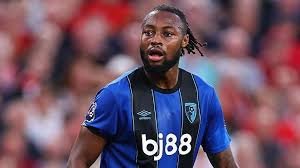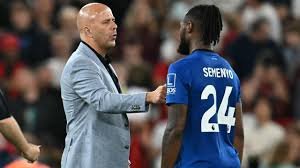
Introduction

On August 15, 2025, during the Premier League season opener at Anfield, Antoine Semenyo, the Bournemouth forward, faced a disturbing moment of racism from a spectator in a wheelchair. This incident led to a temporary halt in the match and sparked a major response from the football community and authorities. Here’s a deep dive into what happened, its broader implications, and how the fight against racism in football continues.
1. What Happened at Anfield
In the 28th–29th minute of Liverpool’s 4–2 victory over Bournemouth, Semenyo reported being targeted with racist abuse by a fan in a wheelchair. Referee Anthony Taylor paused the game, consulted both teams’ coaches and captains, and invoked the Premier League’s anti-discrimination protocol. The match resumed shortly after, once protocol steps were completed.
2. Immediate Reactions from Clubs and Fans
-
Liverpool FC and Bournemouth strongly condemned the incident. Liverpool emphasized: “racism has no place in society or football” and said they would support the police fully.
-
Merseyside Police confirmed an investigation is underway, stressing zero tolerance and discussing the potential for banning orders.
-
The Premier League and The Football Association voiced their “grave concern” and commitment to accountability.
3. The Offender Removed
Authorities identified and removed a 47-year-old man in a wheelchair from the stadium at half-time. Merseyside Police outlined that disciplinary action, potentially including football banning orders, is being proactively pursued.
4. Semenyo’s Response: Resilience on and off the Pitch
Despite the emotional turmoil, Semenyo displayed extraordinary mental strength. He scored both of Bournemouth’s goals in the second half. After the match, he shared a racist social media message he received—monkey emojis—adding poignantly: “When will it stop……”.
Bournemouth manager Andoni Iraola praised his composure while questioning the persistence of racism in 2025: “We have to be talking about something that should be in the past but is not” .
5. Broader Context: Why This Matters
-
The incident cast a shadow over emotional tributes for the late Diogo Jota and his brother, which were the focus of the match.
-
Jamie Carragher, Gary Neville, and other commentators called for tougher measures: permanent bans, criminal proceedings, and more proactive enforcement of anti-racism protocols.
6. Broader Implications & Moving Forward
A. Enforcing Accountability
-
Use of stadium surveillance, stewarding, and collaboration with authorities to quickly identify and remove offenders.
-
Public backlash and robust policing may act as deterrents.
B. Reassessing Protocols
-
Evaluating how quickly and effectively football’s anti-discrimination protocols were activated.
-
Ensuring consistent enforcement across all levels of the game.
C. Support for Players
-
Highlighting the emotional toll on players like Semenyo.
-
Need for institutional support systems—psychological, legal, and social—for those targeted.
D. Culture Change in Football and Beyond
-
Raising awareness among fans and communities about the real impact of racist behavior.
-
Encouraging players and organizations to lead by example, promoting diversity and inclusivity. Semenyo racist abuse.
7. Conclusion: A Defining Moment for Anti-Racism
The racism faced by Semenyo wasn’t just an isolated act—it laid bare flaws in crowd behavior, stadium culture, and enforcement mechanisms. Yet, his response, the unified stance from clubs and authorities, and intensified public scrutiny offer a hopeful path toward meaningful change.
Football must increasingly be vigilant and proactive. That begins with holding perpetrators accountable, supporting victims, and reaffirming that racism has no place in the beautiful game—or anywhere in society.
Frequently Asked Questions (FAQs)
| Question | Answer |
|---|---|
| 1. Why was the match paused? | The game was halted after Semenyo reported racist abuse from the crowd, following Premier League anti-discrimination protocols. |
| 2. Who was responsible? | A 47-year-old man in a wheelchair was identified and removed from the stadium; the police are investigating and may pursue banning orders. |
| 3. What did the clubs say? | Both clubs condemned the abuse. Liverpool affirmed its support for the investigation; Bournemouth praised Semenyo’s composure. |
| 4. How did Semenyo react? | He scored both Bournemouth goals and later shared a racist social media message alongside a poignant comment: “When will it stop…”. |
| 5. What actions are being taken? | Authorities are investigating; football bodies are reinforcing anti-discrimination messaging and considering stronger sanctions. |
| 6. What’s next? | Reinforced enforcement at matches, support for players, and campaigns to raise awareness and reduce racism in football and society. |

Leave a Reply